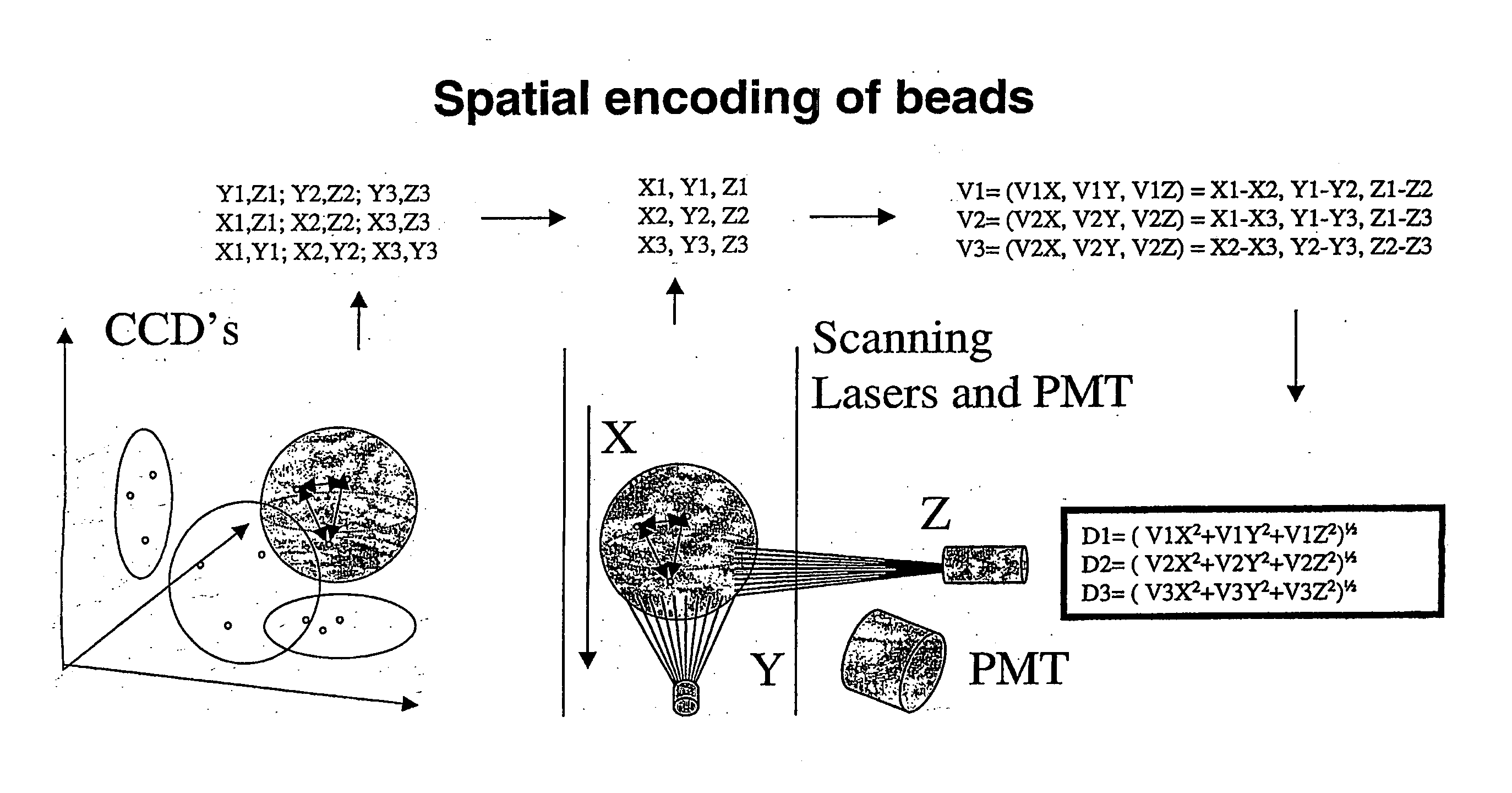Spatially encoded polymer matrix
- Summary
- Abstract
- Description
- Claims
- Application Information
AI Technical Summary
Benefits of technology
Problems solved by technology
Method used
Image
Examples
example 1
Preparation of Encoded (NH2)PEG1900-Acrylamide Copolymer Beads
[0397] Labelled microbeads encoded (Acr)1.4 (NH2)2PEG1900-acrylamide were prepared by inverse suspension polymerisation method. In order to prepare the beads having a size 500 μm, a lower wt % (1.4%) of sorbitan monolaurate with the macromonomer was used as the suspension stabiliser. The n-heptane was used as the suspension medium and was degassed with argon for 1 h before the addition of monomers. In a, typical synthesis procedure, a solution of (Acr)1.4 (NH2)2PEG1900 (7.3 g, 3.54 mmol) in water (21 mL) was degassed with argon for 30 min. Acrylamide (0.36 g, 5 mmol) and the labelled micro beads (20 mg) in water (0.5 mL) were added to the degassed solution and the purging of argon was continued for 5 min. A solution of sorbitan monolaurate (0.1 mL) in DMF (1 mL) and the free radical initiator ammonium persulfate (300 mg) in water (2 mL) were added to the monomer mixture. The reaction mixture was then rapidly added to the...
example 2
Preparation of Microbeads for Encoding
[0398] Synthesis of partially acryloylated (NH2)2PEG500 and (NH2)2PEG1900 Acryloyl chloride (1.267 mL, 14 mmol) in DCM (12 mL) was added dropwise to a solution of (NH2)2PEG500 (6.3 g, 10 mmol) in DCM (18 mL) at 0° C. with stirring. The reaction mixture was kept for 1 h at 20° C. The DCM was evaporated and drying in vacuo at 20° C. yielded the 70% acyloylated (NH2)2PEG500 as colourless thick oil. The partially acryloylated (NH2)2PEG1900 was prepared by following the same procedure with (NH2)2PEG1900 (20 g, 10 mmol) in DCM (12 mL) and acryloyl chloride (1.267 mL, 14 mmol) in DCM (18 mL).
[0399] Synthesis of (Acr)1.4 (NH2)2PEG500-DMA micro beads (28-53 μm):
[0400] A: using high speed stirred reactor:
[0401] Beads of (Acr)1.4 (NH2)2PEG500-DMA (28-53 μm) were prepared by the inverse suspension polymerisation of aqueous solutions of monomers in n-heptane:CCl4 mixture(6:4, v / v, 240 mL). Sorbitan monolaurate was used by 8 wt % of the macromonomer for t...
example 3
Labelling of Encoding Particles
[0404] Labelling of (Acr)1.4 (NH2)2PEG500-DMA (2853 μm) micro beads with Oregon Green 514 dye: The microbeads (0.2 g, 0.8 mmol / g) were kept in DMF / water (5 mL) for 1 h. The Oregon Green™514 carboxylic acid, succinimidyl ester (0.147 g, 0.24 mmol) in DMF (200 μL) was added to the swollen microbeads and the reaction mixture was kept at room temperature. After 1 h, the beads were filtered through a 0.45 micron filter and washed with DMF (10×) and water (10×).
[0405] Labelling of (Acr)1.4 (NH2)2PEG500 (5-28 μm) micro beads with Oregon Green 514 dye: The microbeads (0.2 g, 1 mmol / g) were kept in DMF / water (5 mL) for 1 h. The Oregon Green™514 carboxylic acid, succinimidyl ester (0.184 g, 0.3 mmol) in DMF (200 μL) was added to the swollen microbeads and the reaction mixture was kept at room temperature. After 1 h, the beads were filtered through a 0.45 micron filter and washed with DMF (10×) and water (10×).
[0406] Labelling of (Acr)1.4 (NH2)2PEG500-DMA (28-...
PUM
 Login to View More
Login to View More Abstract
Description
Claims
Application Information
 Login to View More
Login to View More - R&D
- Intellectual Property
- Life Sciences
- Materials
- Tech Scout
- Unparalleled Data Quality
- Higher Quality Content
- 60% Fewer Hallucinations
Browse by: Latest US Patents, China's latest patents, Technical Efficacy Thesaurus, Application Domain, Technology Topic, Popular Technical Reports.
© 2025 PatSnap. All rights reserved.Legal|Privacy policy|Modern Slavery Act Transparency Statement|Sitemap|About US| Contact US: help@patsnap.com



